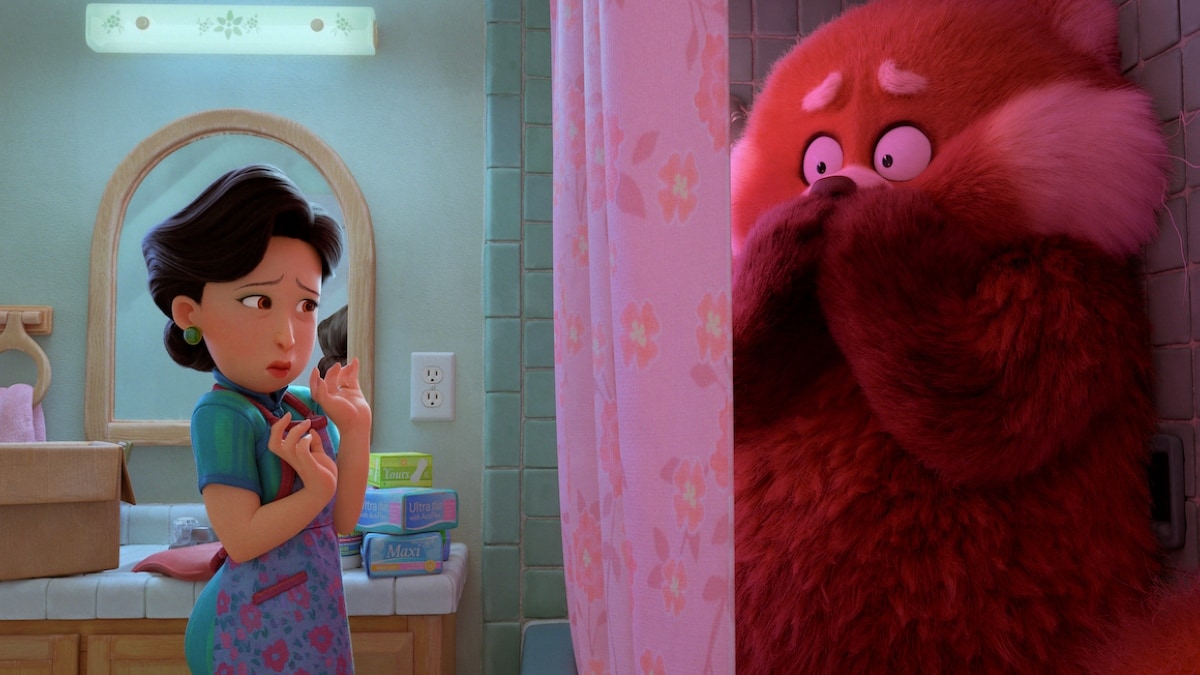In Domee Shi’s vibrant and empathetic Turning Red, she’s crafted a film that, like last year’s Luca, best exemplifies the potential Pixar has to tell character-driven stories that huddle under a universal umbrella. In the first film solely directed by a woman for the studio (Brave was a co-directed feature with Brenda Chapman) Shi infuses the latest from the mega-studio with a specificity of time and place, set in Toronto during the 90s and turning a heartfelt and humorous eye to the innate perils and humiliation of being a 13-year-old tearing through puberty.
Rosalie Chiang voices Mei Lee, a 13-year-old girl who has long been the perfect, obedient daughter to her mother (voiced by Sandra Oh). Studious, bright, and pragmatic, she works at her family’s temple after school and, aside from her obsession with a major boyband and her growing curiosity in boys. This all changes when, after being publicly embarrassed, she wakes up to discover she’s turned into a giant red panda. After realizing this happens when she grows too excited, she soon tries to reign in her spiraling and chaotic motions which can be triggered by anything from the promise of her favorite band going on tour to her mom finding her at school, armed with pads, as she’s worried her daughter started her period at school.
Emotion is less a spectrum as a teenager and more a whirling mixing bowl of mess.
Despite the larger than life storytelling framing – what with the transformation and all and the family legacy that’s tied to it – Turning Red succeeds because it understands how much drama and entertainment is derivative from societal pressures of family and friends, especially when one group is pulling you in the opposite direction of the other.
Read More : Here are the 10 best Pixar movies, at least so far
Insightfully written by Shi along with Julia Cho, the screenplay weaves in the complexities of coming-of-age stories and refuses to belittle its leading lady. Mei is perfectly imperfect, the 13-year-old we all knew (or were) and there’s an abundance of heart in how she and her friends, in particular, are written and the dynamic they share. While her mother sees them as a bad influence, they’re Mei’s lifeline, the figurative tether that helps her stay calm so she doesn’t transform in a burst of pink smoke into a giant panda in public. By managing to subvert expectations – such as when a moment that would typically result in conflict is instead resolved with excitement and glee over an unexpected change in a friend – Turning Red infuses its story with a recognizable heart that allows the nostalgia to reach us.
The animation is superb, due largely to diverging from the style largely set at Pixar as it’s further developed its animation, often exemplified by establishing shots or expansive landscapes which are as photorealistic as a film that isn’t live-action can be. Aside from the overall character design, much of Disney and Pixar’s work has delved into this style, wanting to fully immerse viewers in a “real” experience.
However that’s taken away so much of the beauty of the medium and it’s why again, Luca and this have been such marvels. They aren’t afraid to look like animation, from the characters to the backdrops and the details in between. The work is still intricate and Mei’s fur as the panda is textured as we see it move with her, lending the film a tactile dexterity. However, it allows the motions to be big, the emotions even bigger, with influences from everything from classic anime series such as Sailor Moon (as she referenced in a recent interview with Polygon) to even the stop-motion effects of a film from Laika Studios. There’s a shot in particular of a jarring closeup to Mei’s face where the sweat droplets roll comically down her face that easily could’ve been borne from a different studio. It’s Shi’s eager willingness to stretch what the studio is known for – the stories it tells and how they look – that transforms Turning Red into something that manages to upend expectations.
Of course, there are a few drawbacks, such as a rushed third act and a final beat that seems, perhaps purposefully, cliche. That said, the story of a young girl grappling with the pressures put on her and her deliberation on what it means to love and embrace every aspect of herself, is emotionally potent and allows some of the slighter stumbles to be easily glossed over. Wickedly charming and clever, Turning Red, like its lead character learns to do, wears its heart proudly on its sleeve and is all the stronger because of it.
Advertisement
Turning Red is out now on Disney+. Watch the trailer here.
Advertisement
